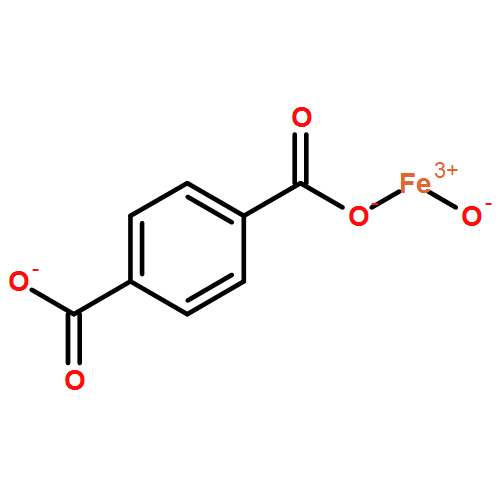
MIL-53(Fe)
MIL-53(Fe)
CAS:764608-47-1
M.F.:C8H5FeO5
M.W.:236.97
Pricing
//
Product: MIL-53(Fe)
Synonyms: NA
CAS:764608-47-1
Basic Information
| Unit MF. | C8H4O5Fe | Unit MW. | 235.96 | ||
| Coordination Metal | Fe | Linkers | Terephathlic acid (CAS:100-21-0) | ||
| Aperture | NA | Pore volume | NA | ||
| Surface Area | N2 BET surface area unavailable | ||||
| Analog Structure |   |
||||
Product Property
| Appearance | Yellow-Brown Powder |  |
||
| Particle Size | 300-600nm | |||
Stability
1) MIL-53(Fe) is stable in air
2) Thermal decomposition temperature greater than 300 ° C
2) Thermal decomposition temperature greater than 300 ° C
Preservation
1) Keep sealed in dry and cool condition
2) It is recommended to activate for 3 hours at 150 degree in vacuum.
Other Features
Fluorescence:NA
Applications
1) Gas (such as carbon dioxide) and pollutant adsorption
2) Lewis acid catalyst
2) Lewis acid catalyst
Characterizations
References
1)T. R. Whitfield, X. Q. Wang, L. M. Liu, A. J. Jacobson, Solid State Sci 2005, 7, 1096-1103, DOI: 10.1016/j.solidstatesciences.2005.03.007 ; Metal-organic frameworks based on iron oxide octahedral chains connected by benzenedicarboxylate dianions;
2)Dengke Wang, Renkun Huang, Wenjun Liu, Dengrong Sun, Zhaohui Li; ACS Catalysis, 2014, 4, 4254−4260; DOI: 10.1021/cs501169t ; Fe-Based MOFs for Photocatalytic CO2 Reduction: Role of Coordination Unsaturated Sites and Dual Excitation Pathways;
3) Dongbo Wang, Feiyue Jia, Hou Wang, Fei Chen, Ying Fang, Wenbo Dong, Guangming Zeng, Xiaoming Li, Qi Yang, Xingzhong Yuan. Journal of Colloid and Interface Science, 2018, volume, issue. DOI:10.1016/j.jcis.2018.02.067. Simultaneously efficient adsorption and photocatalytic degradation of tetracycline by Fe-based MOFs.;
4)Fei-Long Li, Qi Shao, Xiaoqing Huang, Jian-Ping Lang. Angewandte Chemie International Edition, 2018, 57, 1888-1892. DOI:0.1002/anie.201711376. Nanoscale Trimetallic Metal–Organic Frameworks Enable Efficient Oxygen Evolution Electrocatalysis.
5)Yaowen Gao, Simiao Li, Yixi Li, Linyu Yao, Hui Zhang. Applied Catalysis B: Environmental, 2016, volume, issue. DOI:10.1016/j.apcatb.2016.09.005. Accelerated photocatalytic degradation of organic pollutant over metal-organic framework MIL-53(Fe) under visible LED light mediated by persulfate.;
6) Lomig Hamon, Christian Serre, Thomas Devic, Thierry Loiseau, Franck Millange, Gérard Férey, Guy De Weireld; Journal of the American Chemical Society, 2009, 131, 25; DOI:10.1021/ja901587t; Comparative Study of Hydrogen Sulfide Adsorption in the MIL-53(Al, Cr, Fe), MIL-47(V), MIL-100(Cr), and MIL-101(Cr) Metal-Organic Frameworks at Room Temperature.;
7) Cheng-Xiong Yang, Hu-Bo Ren, Xiu-Ping Yan; Anal. Chem. 2013, 85, 15, 7441–7446; DOI: 10.1021/ac401387z; Fluorescent Metal−Organic Framework MIL-53(Al) for Highly Selective and Sensitive Detection of Fe3+ in Aqueous Solution.;
8)Weiping Xiong, Guangming Zeng, Zhaohui Yang, Yaoyu Zhou, Chen Zhang, Min Cheng, Yang Liu, Liang Hu, Jia Wan, Chengyun Zhou, Rui Xu, Xin Li.; Science of the Total Environment, 2018, 633, 1302-1311; DOI:10.1016/j.scitotenv.2018.01.249; Adsorption of tetracycline antibiotics from aqueous solutions on nanocomposite multi-walled carbon nanotube functionalized MIL-53(Fe) as new adsorbent.
